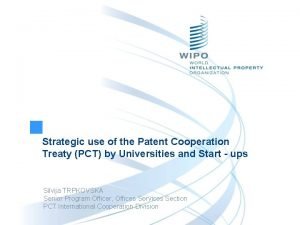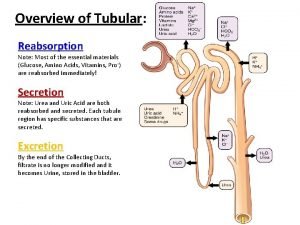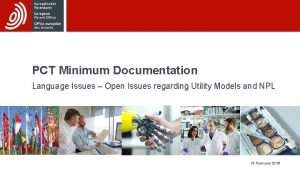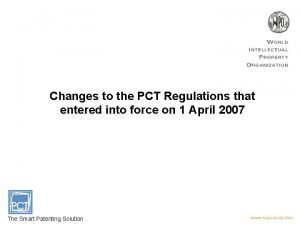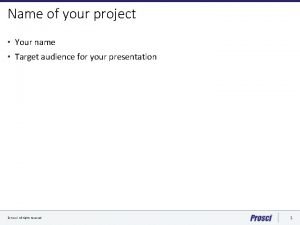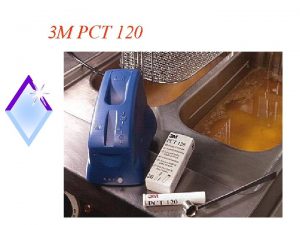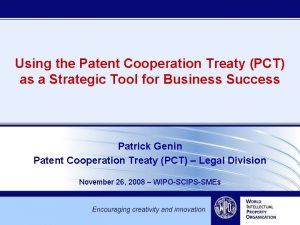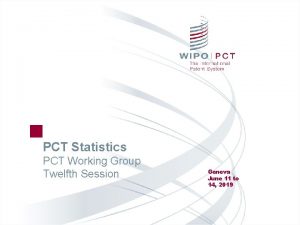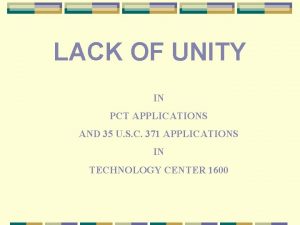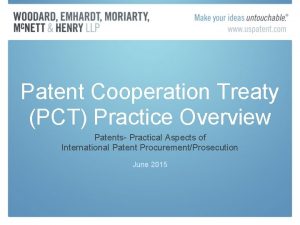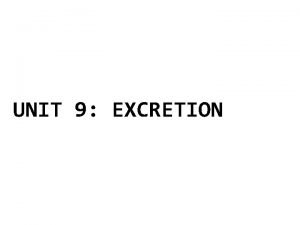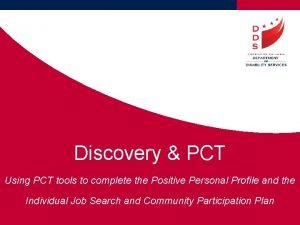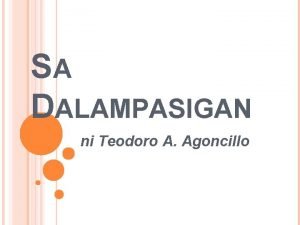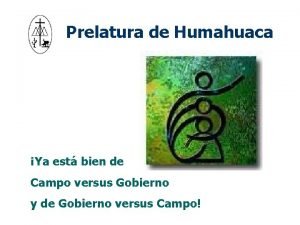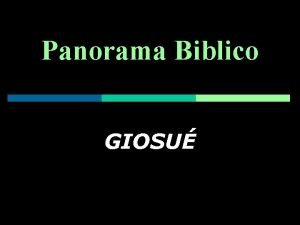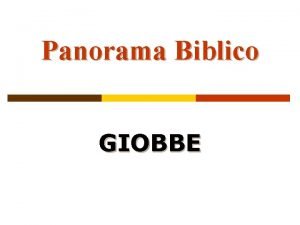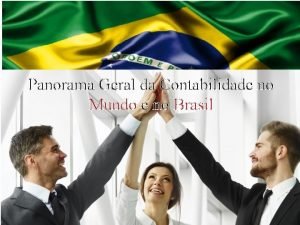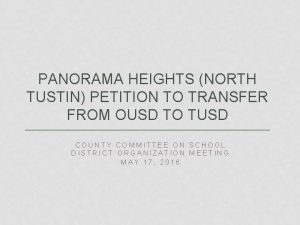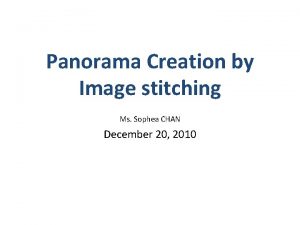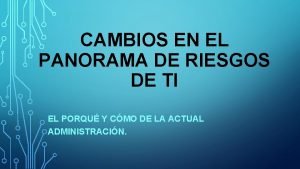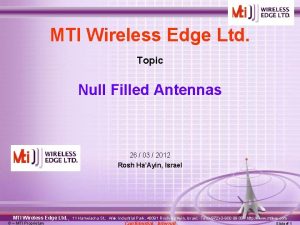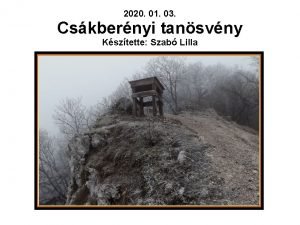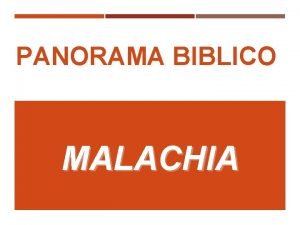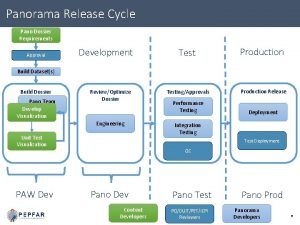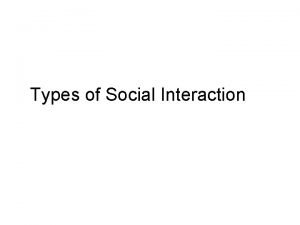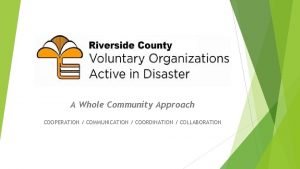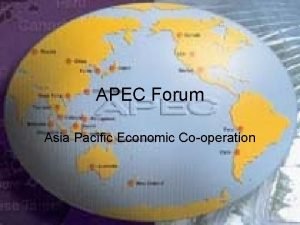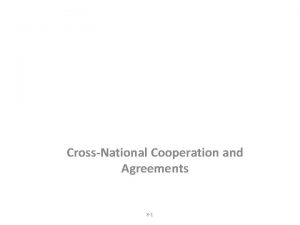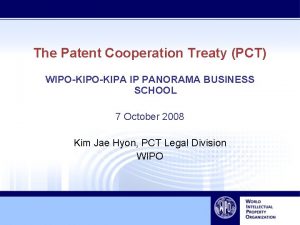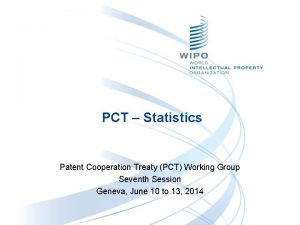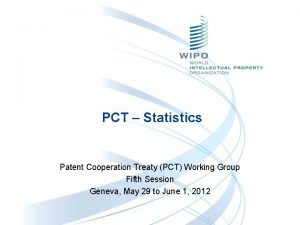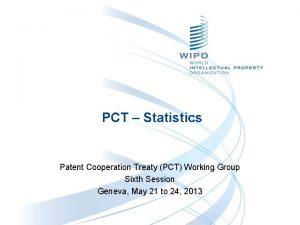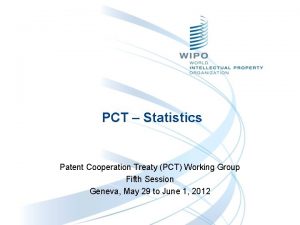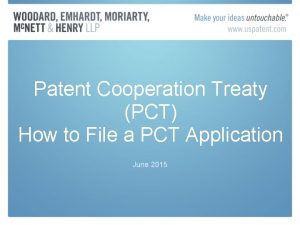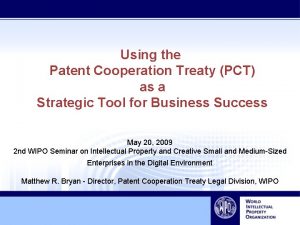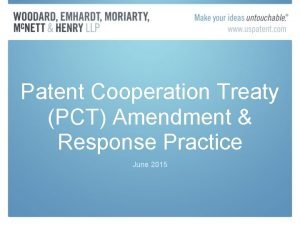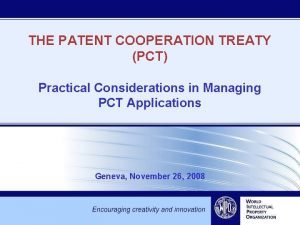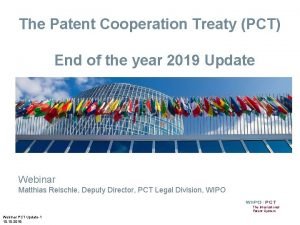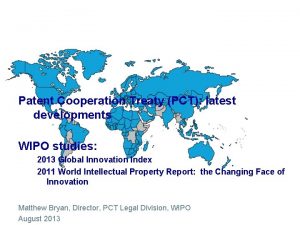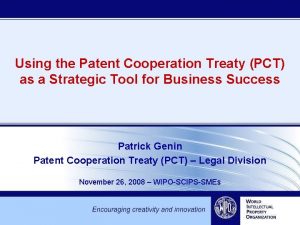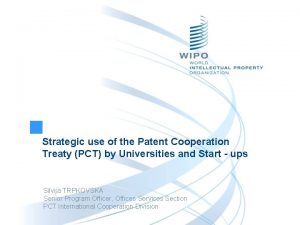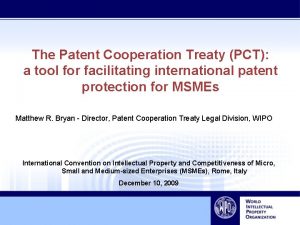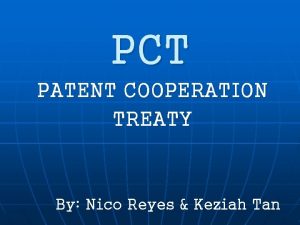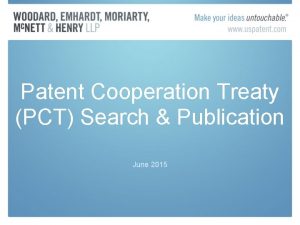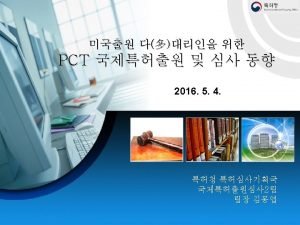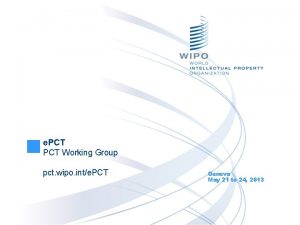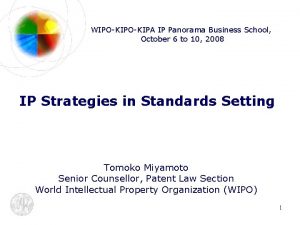The Patent Cooperation Treaty PCT WIPOKIPA IP PANORAMA

















































- Slides: 49

The Patent Cooperation Treaty (PCT) WIPO-KIPA IP PANORAMA BUSINESS SCHOOL 7 October 2008 Kim Jae Hyon, PCT Legal Division WIPO

(1) What is the PCT? (2) Why use the PCT? What are its advantages? (3) Recent PCT Developments (4) Things we’re working on

(1) What is the PCT?

• A mainly procedural international treaty facilitating certain steps in the process of obtaining patents internationally • More specifically, the PCT establishes a procedure for the filing and processing of a single application for a patent which has legal effect in the countries which are Treaty members • Simplifies the procedure for obtaining patent protection in many countries, making it more efficient and economical for: (1) users of the patent system (applicants and inventors); and (2) patent Offices

• The decision on granting patents is made exclusively by national or regional Offices in the national phase • Signed in June 1970, in Washington, D. C. , and became operational in June 1978 with 18 States • As of 27 September 2007, the PCT has 138 Contracting States

138 PCT States =PCT Albania Algeria Angola (27 December 2007) Antigua and Barbuda Armenia Australia Austria Azerbaijan Bahrain Barbados Belarus Belgium Belize Benin Bosnia and Herzegovina Botswana Brazil Bulgaria Burkina Faso Cameroon Canada Central African Republic Chad China Colombia Comoros Congo Costa Rica Côte d'Ivoire Croatia Cuba Cyprus Czech Republic Democratic People's Republic of Korea Denmark Dominican Republic Ecuador Egypt El Salvador Equatorial Guinea Estonia Finland France, Gabon Gambia Georgia Germany Ghana Greece Grenada Guatemala Guinea-Bissau Honduras Hungary Iceland India Indonesia Ireland Israel Italy Japan Kazakhstan Kenya Kyrgyzstan Lao People’s Dem Rep. Latvia Lesotho Liberia Libyan Arab Jamahiriya Liechtenstein Lithuania Luxembourg Madagascar Malawi Malaysia Mali Malta Mauritania Mexico Monaco Mongolia Montenegro Morocco Mozambique Namibia Netherlands New Zealand Nicaragua Nigeria Norway Oman Papua New Guinea Philippines Poland Portugal Republic of Korea Republic of Moldova Romania Russian Federation Saint Lucia Saint Vincent and the Grenadines San Marino Senegal Seychelles Sierra Leone Singapore Slovakia Slovenia South Africa Spain Sri Lanka Sudan Swaziland St. Kitts and Nevis Sweden Switzerland Syrian Arab Republic Tajikistan The former Yugoslav Republic of Macedonia Togo Trinidad and Tobago Tunisia Turkey Turkmenistan Uganda Ukraine United Arab Emirates United Kingdom United Republic of Tanzania United States of America Uzbekistan Viet Nam Yugoslavia Zambia Zimbabwe

Growth in PCT member States over last 10 years 1996 1997 Yugoslavia Turkey Ghana Israel Zimbabwe Cuba Sierra Leone Saint Lucia Indonesia Bosnia and Herzegovina Gambia Guinea. Bissau 1998 1999 2000 2001 2002 2003 2004 2005 2006 Cyprus Croatia Grenada India Algeria Antigua and Barbuda Mozambique Belize Colombia Saint Vincent Ecuador and the Equatorial Grenadines Guinea Seychelles Philippines Oman Zambia Tunisia Papua New San Marino Guinea Syrian Arab Republic Egypt Botswana Comoros Nigeria Libyan Arab Jamahiriya St. Kitts and Nevis Honduras El Salvador Malaysia Lao People’s Democratic Republic Guatemala United Arab Emirates South Africa Costa Rica Dominica United Republic of Tanzania Morocco 2007 Malta Bahrain Dominican Republic Angola

Growth in PCT filings

PCT Filing forecasts

The PCT System --typical use, in more detail (months) 0 12 File local application File PCT application International publication 16 18 International search report & written opinion Enter national phase 22 28 (optional) File demand for International preliminary examination (optional) International preliminary report on patentability 30

The PCT System --typical use, in more detail (months) 0 File local application Typically a national patent application in the home country of the applicant 12 File PCT application International publication 16 18 International search report & written opinion Enter national phase 22 28 (optional) File demand for International preliminary examination (optional) International preliminary report on patentability 30

The PCT System --typical use, in more detail (months) 0 12 File local application File PCT application International publication 16 18 International search report & written opinion Typically filed in same national patent office--one set of fees, one language, one set of formality requirements--and legal effect in all PCT States Enter national phase 22 28 (optional) File demand for International preliminary examination (optional) International preliminary report on patentability 30

The PCT System --typical use, in more detail (months) 0 12 File local application File PCT application International publication 16 18 International search report & written opinion Report on state of the art (prior art documents and their relevance) + initial patentability opinion Enter national phase 22 28 (optional) File demand for International preliminary examination (optional) International preliminary report on patentability 30

The PCT System --typical use, in more detail Disclosing to world content of application in standardized way (months) 0 12 File local application File PCT application International publication 16 18 International search report & written opinion Enter national phase 22 28 (optional) File demand for International preliminary examination (optional) International preliminary report on patentability 30

The PCT System --typical use, in more detail (months) 0 12 File local application File PCT application International publication 16 18 International search report & written opinion Enter national phase 22 (optional) File demand for International preliminary examination Request an additional patentability analysis on basis of amended application 28 (optional) International preliminary report on patentability 30

The PCT System --typical use, in more detail (months) 0 12 File local application File PCT application International publication 16 18 International search report & written opinion Enter national phase 22 28 30 (optional) File demand for International preliminary examination (optional) International preliminary report on patentability Additional patentability analysis, designed to assist in national phase decisionmaking

The PCT System --typical use, in more detail (months) 0 12 File local application File PCT application International publication 16 18 International search report & written opinion Express intention and take steps to pursue to grant in various states Enter national phase 22 28 (optional) File demand for International preliminary examination (optional) International preliminary report on patentability 30

(2) Why use the PCT? What are its advantages?

As the cornerstone of the international patent system, the PCT provides a worldwide system for simplified filing and processing of patent applications, which-1. brings the world within reach 2. postpones the major costs associated with internationalizing a patent application 3. provides a strong basis for patenting decisions 4. is used by the world’s major corporations, universities and research institutions when they seek international patent protection 5. allows you to apply securely and easily online, and to save money by doing so

1. Brings the world within reach How? PCT application = Legal effect of a regular national patent application in all PCT States

2. Postpones the major costs associated with internationalizing a patent application

What are those large initial costs? 1) Translations of the patent applications (which are highly technical documents) into various national languages 2) Official fees for payment to national/regional patent offices (for example, filing fees, claims fees, etc. ) 3) Fees for the services of local patent agents/attorneys in the designated states

When are these costs incurred?

Traditional patent system vs. PCT system Fees for: --translations --Office fees --local agents (months) Traditional 0 12 File applications abroad Fees for: File local application --translations --Office fees --local agents International publication (months) PCT 0 File local application Enter national phase 12 16 File PCT application International search report & written opinion 18 22 28 (optional) File demand for International preliminary examination (optional) International preliminary report on patentability 30

PCT Costs--in perspective According to IP Global Estimator, the total cost of hypothetical application (RO/US, ISA/EP, 46 pages/12 claims w/3 independent, national phase in AU, CA, EPO, JP, MX, US, and EP validation in DE, FR, GB, IT, NL & SE, + maintenance fees--from filing until expiration of 12 national phase patents at 20 years from the filing date) would be USD $232, 742 Thus, the PCT filing fees, including the international search by the EPO, (total: USD $3, 637) represented 1. 6% of what the PCT applicant could expect to pay throughout the full life of this patent family If the payment of annual maintenance fees is eliminated from the above calculation, the total amount that the applicant would expect to pay to see his/her patents granted is reduced to USD $86, 398. PCT filing fees would then represent 4. 2% of this amount [Estimate date: July 1, 2007]

3. Provides a strong basis for patenting decisions

Together with the time gained (as previously explained) and the postponement of the significant costs, it is the information about the potential patentability of the invention that is received during the PCT process which is the most valuable for the PCT applicant

What does this potential patentability information consist of?

In Chapter I of the Treaty (before the international publication), it is the content of the International Search Report (ISR) and the Written Opinion of the International Searching Authority In Chapter II of the Treaty (after international publication), it is the content of the International Preliminary Report on Patentability (Chapter II) (IPRP (Ch. II))

Example: international search report Symbols indicating which aspect of patentability the document cited is relevant to (for example, novelty, inventive step, etc. ) Documents relevant to whether or not your invention may be patentable The claim numbers in your application to which the document is relevant

Example: written opinion of the ISA Reasoning supporting the assessment Patentability assessment of claims

Example: international preliminary report on patentability (Ch. II) Reasoning supporting the assessment Patentability assessment of claims (usually, as amended)

What does the applicant do with the information from the ISR, ISO and IPRP Ch. II? He/she uses it as a basis for their patenting decisions--decisions about: 1) whether to enter the national phase 2) where to enter the national phase Example-Based on the information received during both Chapters I and II, the Procter & Gamble company found that it: --abandoned 20% of PCT filings at national phase (did not enter national phase at all anywhere); --when it did enter national phase, it did so in only 70% of the States it had originally intended to patent in

4. Is used by the world’s major corporations, universities and research institutions when they seek international patent protection

International applications received in 2007 by country of origin

Top PCT Applicants (2007)

TOP Korean PCT users • • • LG Electronics Samsung Electronics LG Chemicals ETRI – Electronics & Telecom. Research Institute Seoul National University POSCO – Pohang Iron & Steel Company AMORE PACIFIC CORP. LG Innotek Co. Ltd. KIST – Korea Institute of Science & Technology

5. apply securely and easily online, and save money for doing so!

PCT Electronic filing overview 1. Prepare application body: in XML using the PCT-SAFE Editor or in PDF 2. Prepare Request using free, WIPO-produced PCTSAFE software 010101 0 101010 1 010101 Signatur 0 e 5. Receive a receipt (for online filings) 3. Electronically sign: WIPO Customer digital certificate or other 4. Transmit (on-line or on CD-R)

PCT E-filing fee reductions · 100 Swiss francs: paper filings request printout created with PCT-SAFE diskette prepared with PCT- SAFE · 100 Swiss francs: electronic filings request not in character coded format (for ex. , PDF) · 200 Swiss francs: electronic filings text of application not in character coded format (for example, PDF) · 300 Swiss francs: electronic filings text of application in character coded format (for example, XML)

39. 5% of IAs filed fully electronically Less than 40% are filed on paper only 23 receiving Offices accept PCT electronic filing

(3) Recent PCT developments

1 April 2007 Amendments to the PCT Regulations Effective April 2007: • restoration of the right of priority (PCT Rule 26 bis. 3) • applications filed with parts missing (PCT Rule 20) • addition of patent documents of the Republic of Korea to the PCT minimum documentation (PCT Rule 34. 1)

1 July 2008 Changes to the PCT Regulations and other changes Effective July 2008: • Use the results of an earlier search (PCT Rule 12 bis. 1) • Use of e-mail address, for receiving communication from a PCT office, in the PCT Request (Form PCT/RO/101)

1 January 2009 Amendments to the PCT Regulations • Supplementary International Search (PCT Rule 45 bis) • Korean is a PCT publication language (PCT Rule 48. 3)

(4) Things we’re working on

PCT-related projects currently underway • Priority document digital access service • Extension of national phase entry information availability – 30 Offices currently providing data, with 1. 2 million national phase notifications, updated monthly • Patent landscaping tools • Private file inspection • XML processing • Terminology database/Multilingual searching • National patent collections

Future PCT Issues • • Comprehensive review of PCT minimum documentation PCT solution for color drawings EPO future proposal for claims fees in PCT Ramifications for PCT of new US rules on claims and continuations • Potential for creating online repositories of national and PCT search and examination reports • New PCT translation paradigm, building on multilingual searching

Questions?
 Pct example
Pct example Where does water reabsorption occur
Where does water reabsorption occur Wirral primary care trust
Wirral primary care trust Pct minimum documentation
Pct minimum documentation Pct rule 91
Pct rule 91 Procalcitonin là gì
Procalcitonin là gì Your name target
Your name target Oxifrit
Oxifrit Pct example
Pct example Pct working
Pct working Pct example
Pct example Iprp pct
Iprp pct Label the nephron answers
Label the nephron answers Pct working
Pct working Positive personal profile
Positive personal profile Dr scally power pct
Dr scally power pct Essjayericsson mail
Essjayericsson mail Elehiya halimbawa
Elehiya halimbawa Dirio panorama
Dirio panorama Bacteria disinfection panorama city
Bacteria disinfection panorama city Panorama biblico
Panorama biblico Prenatal
Prenatal Panorama biblico
Panorama biblico Panorama contabilidade
Panorama contabilidade Panorama heights preschool
Panorama heights preschool Panorama creation
Panorama creation Kaiser permanente wa pharmacy
Kaiser permanente wa pharmacy Panorama stitching algorithm
Panorama stitching algorithm Panorama stitching
Panorama stitching Panorama de riesgos de una empresa
Panorama de riesgos de una empresa (“mti wireless edge” or mtiwe) and anten
(“mti wireless edge” or mtiwe) and anten Esquema del panorama del periodo
Esquema del panorama del periodo Mobility landscape in mobile app development
Mobility landscape in mobile app development Pastas panorama
Pastas panorama Panorama general del sistema financiero
Panorama general del sistema financiero Vértesi panoráma tanösvény
Vértesi panoráma tanösvény Pcnse certificate
Pcnse certificate Panorama biblico
Panorama biblico Pepfar panorama
Pepfar panorama Social interaction cooperation
Social interaction cooperation Communication cooperation coordination collaboration
Communication cooperation coordination collaboration Asia pacific economic forum
Asia pacific economic forum International laboratory accreditation cooperation
International laboratory accreditation cooperation Cross national cooperation
Cross national cooperation Offer for cooperation
Offer for cooperation Christianity
Christianity Business process cooperation viewpoint
Business process cooperation viewpoint Atılım üni erasmus
Atılım üni erasmus Evaluation cooperation group
Evaluation cooperation group Agriculture cooperation and farmers welfare
Agriculture cooperation and farmers welfare
